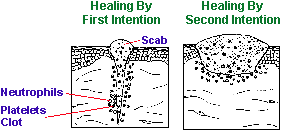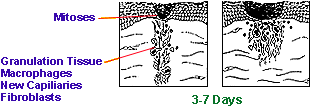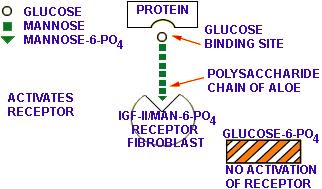The Healing Properties Of Aloe VeraAloe vera contains Glucomannan, a special complex polysaccharide composed largely of the sugar mannose. It interacts with special cell-surface receptors on those cells which repair damaged tissues, called fibroblasts, stimulating them, activating their faster growth and replication. Plant hormones in Aloe, called gibberellins, also accelerate healing by stimulating cell replication. These combined actions make Aloe a uniquely potent healing Herb.
Figure 1 Processes Which Heal Damaged TissuesWounding does not just cause trauma to one cell type. Whichever part of the body is wounded, the skin is broken and it is also likely that sub-dermal connective tissues are damaged. Such damage makes it inevitable that blood vessels will have been cut through, spilling some blood within the wound, which then clots. Therefore, even if the wound is quite superficial, so long as the skin itself is penetrated, at least three tissue types are involved. Obviously, much deeper wounds are likely to involve muscle tissue. I do not address here the question of very serious injury involving bone, nerves and internal organs.Within a few hours of wounding, a single layer of epidermal cells starts to migrate from the skin edges to form a delicate covering over the raw area beneath. The chief feature of this process, at least at first, is the movement of already existing epidermal cells over the wound surface, though it is very likely backed up by some cell multiplication. Some 36 to 72 hours after wounding, the predominant cell-type in the inflammation fluid is seen to be macrophages. Whilst these cells are well known as phagocytes there is good evidence that they do more than just phagocytose. The microphage infiltration is followed a day or two later by a proliferation of fibroblasts, cells which produce fibres of collagen and also produce other tissue proteins. By the sixth day thick fibres are present which show the staining reactions of collagen and these tend to be orientated parallel to the skin surface and across the axis of the wound, giving the repair some strength. At the same time, the fibroblasts are producing “proteoglycans” (macro-molecules which combine polysaccharide and protein elements), and these form the underlying matrix for the new connective tissue which is being formed. Both macrophage infiltration and fibroblast proliferation are accompanied by ingrowth into the wound of small capillary buds which are derived from intact small blood vessels of the dermis (i.e. the skin layer beneath the outer epidermis) near the wound edges. Initially these buds consist of solid ingrowths of endothelial cells, but they soon acquire a lumen. At first these new blood vessels are rudimentary in structure and, compared with normal vessels, they are very leaky. The newly vascularized, collagen-producing tissue is called “granulation tissue” because it appears granular on its surface due to the little knots of delicate bloods vessels which show there.
Figure 2 Another process important in wound-healing is wound contraction. In the case of larger open wounds, after two or three days the wound area starts to contract. This is a real movement of the wound margins and is independent of the rate at which covering by new epithelium takes place. This does not seem to be related to the formation of collagen in the wound either and, indeed, appears to happen before very much collagen has been laid down. The effect is ascribed to a different type of cell having a mixture of the properties of fibroblasts and smooth muscle cells and consequently called “myofibroblasts.” These cells do, in fact, contain actin, the contractile protein of muscle and it appears to be this protein which shortens in order to produce contraction of the wound area. Various controlling influences are at work in the process of healing, several of them involving chemical messengers that provide communication between cells and hence directing the onward flow of events. For example, in the case of the migration and multiplication of epithelial cells, the loss of cell-cell contact by the cells at the edge of the wound may well be a factor which starts their migration. On the other hand, there are thought to be substances which normally inhibit the migration of epithelial cells, called “chalones.” It may be the lack of these chalones which initiates the migration into the wound, or alternatively there may be yet other chemical messengers which give these cells a positive stimulus. Relatively little is known about this or about the causes of the migration of the blood vessels. However, there is a little more information about the fibroblasts. These do appear to be subject to stimulation by external chemical messengers. It is most likely that these cells are stimulated, or their functions modified by, cell messengers from the damaged tissues, possibly by glycoproteins of the type called “fibronectins.” If these particular substances do not actually stimulate multiplication, they certainly do affect other aspects of fibroblast function. They are very much concerned with the laying down of collagen fibres. In response to injury of tissue, fibroblasts are stimulated to migrate, to multiply and to accelerate their production of both collagen and proteoglycan matrix. The fact that these substances are of a glycoprotein nature may well be important in relation to the way in which Aloe influences these same cells. The Ways In Which Aloe Influences The Healing ProcessesIt is necessary to turn now to the specific “Healing” effect of Aloe. This is certainly a separate type of action from the Anti-Inflammatory effect described in Newsletter No. 2. The latter effect, as we have seen, calls for the inhibiting of certain processes, such as cholesterol synthesis, the inhibiting of prostaglandin formation, or the inhibiting of bradykininase enzyme. By complete contrast with this, a healing action calls, as we have seen, for the positive stimulation of those cells which grow and multiply to effect the formation and physical strengthening of wound tissues. The process of healing has more in common with the process of immune stimulation - since both are positive stimulatory processes, not inhibitory.Effect Of Mannans And GlucomannansIt is not surprising, therefore, that since these two processes of immune stimulation and healing have something in common, that they should also be linked in another way. Both seem to reside, at least in part, in the high molecular weight carbohydrate-rich fraction of Aloe. In Newsletter No. 1 it has been clearly shown how the immune stimulation effect is mediated through this fraction. That the healing action is also at least partly mediated through this fraction is also clearly demonstrated in the published literature. For example, a paper by Tizard, Carpenter, & McAnalley, 1989, entitled “The Biological Activities of Mannans and related complex Carbohydrates,” addresses itself more generally to the question of the biomedical effects of mannose-containing carbohydrates of this type, wherever they come from. The authors conclude that “mannose containing products increase macrophage activity and promote wound-healing. Stimulation of macrophages will increase cell and tissue growth, fibroblast activity and fibroblast proliferation. Aloe, containing mannose, "may also promote wound-healing in this way.”The stimulatory nature of the immune system effects were cited by J.C. Pittman in 1992 in a short review and summary entitled “Immune enhancing effects of Aloe.” This quotation was “Acemannan has direct effects on the immune system, activating and stimulating macrophages, monocytes, antibodies and T-cells.” Acemannan is a trade name which has been applied to the mannose-rich polysaccharide fraction from Aloe. Prof. Davis et al. found that Aloe vera increases Collagen (protein) and proteoglycan synthesis, and that this results in increased tissue repair without loss of anti-inflammatory activity. They suggested that the mechanism might be that mannose-6-phosphate fits the growth factor receptors on the surface of the fibroblasts, enhancing their activity. This paper is Davis, Didonato, & Hartman, “Anti-inflammatory and wound-healing activity of a growth substance in Aloe vera,” 1994. This very mechanism has been referred to above, showing a route to the stimulation of fibroblasts - cells which produce collagen (protein) fibres to strengthen the new tissue formations which heal wounds. Inherent within this idea, is the concept that fibroblast cells - which are key cells in forming the structure of connective tissue - possess special receptors of the type discussed, which are sensitive to mannose-6-phosphate and hence to mannose-containing polysaccharides, mannose-containing glycoproteins, and breakdown products derived from these large mannose-rich molecules. Macrophages and other immune cells have similar surface receptors. This is reflected in a paper by Winters (1993). After presenting experimental results, Winters declares “These results suggest that these Aloe lectins were active at alpha D-glucose and mannose sites and not at n-acetyl glucosamine sites.” The white blood cells being used in this work appear to have been predominantly lymphocytes.
Figure 3 Hence, it appears that the “final common pathway” for initiating both the immune-stimulatory effect and the tissue-healing effect of Aloe, is the stimulation of predominantly mannose-sensitive cell-surface receptors. In the one case the cell-surface involved is that of immune system cells, and in the other it is the surface of the fibroblasts of connective tissues. The following diagram has been drawn up by Professor Davis, to illustrate the way in which the glucomannan - a mixed polysaccharide comprising mainly mannose sugar but containing also a little glucose - interacts with the cell surface of the fibroblast.
Plant Growth HormonesProf. Davis considers that gibberellin (a plant growth hormone) in Aloe increases wound-healing by increasing protein synthesis. It has been said to do this by binding to a section of DNA and consequently affecting the copying of the DNA so as to make protein. The authors Davis, Didonato, & Hartman, in “Anti-inflammatory and wound-healing activity of a growth substance in Aloe vera,” 1994, say that gibberellin, isolated from Aloe, increased wound-healing more than 100% in mice. Indole-3-acetic acid, an auxin, which is also a plant growth hormone, was also reported to increase protein synthesis by increasing up take of amino acids. Little work directly upon gibberellin in Aloe appears to have been published, but one paper which mentions it specifically is “Aloe vera and gibberellin: anti-inflammatory activity in diabetes,” by Davis & Maro, 1989. Some of the amino acids have also been referred to as growth-stimulants by Prof. Davis’s group, but no definite role for these has yet been clarified, nor attributed with any certainty to any individual amino acids.SummaryFrom all the foregoing, it can be seen that the mechanisms of the healing action are multi-factorial. That is to say, they are the result of a good many factors coming together and exerting their own distinct influences simultaneously, to produce the overall effects. The knowledge which has been gathered is impressive, though it falls short of complete explanation or complete understanding. Nonetheless, it serves to give a fair mental image of the types of processes that are going on when Aloe exerts its effects.In the future Newsletter, it will be possible to consider ways in which the three prime known actions of Aloe work in concert, not only with each other, but also with the known secondary effects of Aloe, to produce important beneficial effects upon chronic illness. It also becomes possible to address the question, as to which medical conditions which have not yet been subjected to medical trials with Aloe, most stand to benefit, on theoretical and inferential grounds, from the future application of the therapeutic effects of Aloe. References Confirming The Wound-Healing Powers Of AloeIn the following list of publications most refer to observations upon the actual practical healing of wounds. However, a few references have been included which simply report a mitogenic effect, i.e. an effect in stimulating cellular multiplication of a tissue, since that is such a fundamental component of the healing process.Barnes T 1947: The healing action of extracts of Aloe vera on abrasions of the human skin. Amer. J. Botany 34. Freytag A 1954: Suggested role of Traumatic acid in Aloe wound healing. Parmazle 9 705. Goff S; Levenstein L 1964: Measuring the effects of topical preparations upon the healing of skin wounds. J. Soc. Cosmetic Chemists 15 509-518. El Zawahry M; Hegazy M; Helal M 1973: The use of Aloe in treating leg ulcers and Dermatoses. Int. J Dermatol 12 68-73. Kawashima S; Shinho M 1979: Suggestion that a polysacch. is Aloe’s wound healer. Jpn. Kokai Tokkyo Koho 79 151113 Chem Abs. 93 113075y. Winters WD; Benavides R; Clouse WJ 1981: Effects of Aloe Extracts on human normal and tumor cells in vitro. Economic Botany 35 (1) pp. 89-95.v. Robson MC; Heggers JP; Hagstrom WJ 1982: Myth, Magic, Witchcraft or Fact. Aloe vera Revisited JBCR 3 157-163. Rubel B 1983: Possible mechanisms of the healing actions of Aloe vera gel. Cosmetics and Toiletries 28 109-114. Yagi A; Machll H; Shida T; Nishloka L 1985: Effect of Aloe Lectin on Deoxyribonucleic acid synthesis in baby hamster kidney cells. Stimulation of RND Synthesis by an Glycoprotein. Experientia 41 669-671. Davis RH; Kabbani JM; Maro NI 1987: Aloe vera and wound healing. J Am Podiatr Med Assoc. 78 (2) 165-9. Davis RH; Leitmer MG; Russo JM 1988 Aloe vera: A natural approach for treating wounds, oedema and pain in Diabetes. J. of the American Podiatric Medical Assoc. 78 (2) 60-68. Fan YJ; Li M Yang WL; Qin L; Zou J 1989: Protective effect of extracts from Aloe Vera L. Var. Chinensis (Haw.) Berg. On experimental Hepatic lesions & a primary clinical study on the injection of in patients with Hepatitis. Chung Kuo Chung Yao Tsa Chin 14 (12) 746-748. Davis RH; Lettner MG; Russo JM; Byrne ME 1989: Wound healing. Oral & topical activity of Aloe Vera. J. Amer. Podiatric Med. Assoc. 79 (11) Nov., 559-562. Fulton JE Jr 1990: The stimulation of post-dermabrasion wound healing with stabilized Aloe vera gel/poly-ethylene oxide dressing. J Dermatol Surg Oncol 16 (5) 460-467. Heggers JP; et al (8 authors) 1992 (Dec.): Wound healing potential of Aloe & other chemotherapeutic agents. Presented in part at the 6th Internat. Congress on Traditional and Folk Medicine. Heggers JP; Pelly RP; Robson MC 1993: Beneficial effects of Aloe in wound healing. Phytotherapy Research 7 548-552. Skohan SJ; Davis RH 1993: Principals of wound healing and growth factor considerations. J. Amer. Podiatric. Med. Assoc. 83 (4) April. 223-227. Heggars JP; et al (7 authors) 1994: Beneficial effect of Aloe on wound healing in an excisional model. Presented at the 26th Ann. Meeting of the American Burns Assoc. April. Davis RH; Didonato JJ; Johnson WS; Stewart CB 1994: Aloe vera, Hydro-cortisone, & sterol influence on wound tensile strength and anti-inflammation. J. Amer. Podiatric. Med. Assoc. 84 614-621. Davis RH; Di Donato JJ; Hartman GM; Haas RC 1994: Anti-inflammatory & wound healing activity of a growth substance in Aloe vera. J. Amer. Podiatric Med. Assoc. 84 (2) Feb., 77-81. Many potential users of Aloe ask “If Aloe stimulates cell division, can it not also stimulate the growth of cancer cells?” In the following paper tests were done with normal human cells and also human cancer cells and the results showed that although the growth of the normal cells were stimulated, that of the cancer cells was not. Winters WD; Benavides R; Clouse WJ 1981: A note from “Effects of Aloe extracts on human normal & tumor cells in vitro. Economic Botany 35 (1) pp. 89-95. Fractions of leaf extracts from Aloe vera and Aloe saponaria were prepared by differential centrifugation and tested by in vitro assays for the presence of lectin-like activities and for effects on the attachment and growth of human normal and tumour cells. Fractions of extracts of fresh leaves had high levels of lectin-like substances measured by immunodifusion and haemagglutinin assays. Substances in fluid fraction from both fresh leaf sources were found to markedly promote attachment and growth of human normal, but not tumour, cells and to enhance healing of wounded cell monolayers. Results from cell assays suggested that the observed growth promotion and wound healing effects of Aloe substances in vitro may be analogous to what has been observed in vivo during healing of wounds and burns. The Healing Properties Of Whole Leaf Aloe Vera |
Whole Leaf Aloe Vera - Home Whole Leaf Aloe Vera Products Aloe Vera Information



 It shows a section of a glucomannan molecule, linked to protein by a glucose sugar unit and by a
chain of mannose sugar units to the cell surface receptor. The cell is shown as being the fibroblast. It does
seem most likely that the glucomannan does react with the fibroblasts directly. However, there is an
alternative theory which is not yet excluded - that the macrophages are stimulated first and then release
chemical messengers, which in turn stimulate the fibroblasts.
It shows a section of a glucomannan molecule, linked to protein by a glucose sugar unit and by a
chain of mannose sugar units to the cell surface receptor. The cell is shown as being the fibroblast. It does
seem most likely that the glucomannan does react with the fibroblasts directly. However, there is an
alternative theory which is not yet excluded - that the macrophages are stimulated first and then release
chemical messengers, which in turn stimulate the fibroblasts.